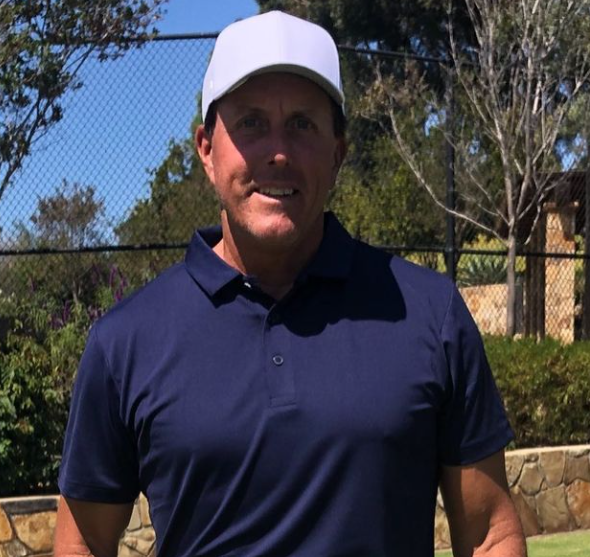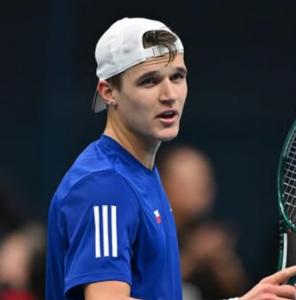Phil Mickelson’s Tribute to Paul Casey and Peter Kostis: A Farewell to an Era of Golf Excellence
Phil Mickelson recently took to social media to share a heartfelt message in response to fellow LIV Golf player Paul Casey’s decision to part ways with his longtime coach, Peter Kostis.1
The announcement marks the end of an extraordinary 23-year relationship between Casey, one of England’s most accomplished golfers, and Kostis, a legendary golf coach and analyst. Together, they built a legacy of success and friendship that left a lasting impact on the golfing world.
Table of Contents
The Beginning of a Dynamic Partnership
- Paul Casey’s professional journey with Peter Kostis began in 2000, the year Casey turned pro after a successful amateur career. Kostis, who was already renowned for his work with elite players, quickly recognized Casey’s raw talent and took him under his wing.
- Under Kostis’ guidance, Casey’s game flourished, and he became one of the most prominent figures in golf, especially on the European Tour.
- Kostis’ coaching methods and experience played a crucial role in Casey’s early development, helping him hone his swing, fine-tune his short game, and develop the mental fortitude necessary for success.
- Over the years, their partnership evolved beyond the professional, forming a friendship built on trust, respect, and shared goals.
A Journey Marked by Milestones and Success
- With Kostis by his side, Casey’s career witnessed numerous milestones. He claimed over 20 professional wins, including victories on both the European and PGA Tours.
- His success on the European Tour included memorable wins at events such as the BMW PGA Championship, which showcased his skill and versatility on the course.
- Casey’s prowess in match play events, notably in the Ryder Cup, made him a valuable asset to the European team, contributing to their success across multiple tournaments.
- Casey’s partnership with Kostis also extended into LIV Golf, where he joined players like Mickelson in the pursuit of elevating the game on a global stage.
- Through both wins and challenges, Kostis remained a steadying force, helping Casey refine his technique, regain confidence, and maintain consistency in his game.
Mickelson’s Tribute to a Remarkable Coach-Player Bond
Phil Mickelson’s message highlighted the deep respect he holds for both Casey and Kostis, recognizing the unique and enduring bond they shared. Mickelson, who has long been known for his close relationships within the golf community, admired the mentorship Kostis provided to Casey and the dedication Casey showed in reciprocating his coach’s trust.
Also Read: Phil Mickelson Praises Stallion Bryson DeChambeau on His Second Major Victory at the 2024 US Open
Phil Mickelson’s Long-Term Partnerships: A Key to His Success
Much like Paul Casey’s enduring relationship with Peter Kostis, Phil Mickelson has enjoyed long-term coaching partnerships that have been instrumental in shaping his golf career. Since 2015, Mickelson has worked with Andrew Getson, an Australian swing coach whose insights have helped Mickelson remain competitive, even into his 50s.2
View this post on Instagram
Before Getson, Mickelson was under the tutelage of renowned swing coach Butch Harmon from 2007 to 2015. These consistent partnerships reflect Mickelson’s appreciation for the stability and expertise a trusted coach can bring to his game.
Building a Partnership with Andrew Getson
When Mickelson began working with Getson in 2015, he was looking for a fresh perspective to refine his swing. Getson’s approach to biomechanics and swing mechanics resonated with Mickelson, who found the techniques offered a renewed sense of control and power.3
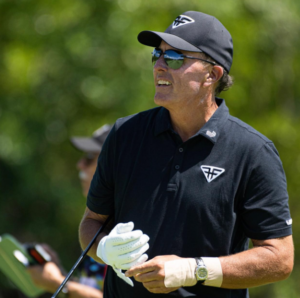
Under Getson’s guidance, Mickelson went on to achieve some remarkable milestones, including his historic win at the 2021 PGA Championship at the age of 50, making him the oldest major champion in golf history.
The Legacy of Butch Harmon’s Coaching
- Before Getson, Mickelson worked with Butch Harmon, one of the most successful and influential golf coaches in the world.
- From 2007 to 2015, Harmon helped Mickelson refine his game, notably improving his driving accuracy and distance, which were areas that Mickelson previously struggled with.
- Under Harmon’s mentorship, Mickelson won multiple tournaments, including his third Masters title in 2010.
- Their partnership set the foundation for many of Mickelson’s career highlights, and Harmon’s influence is still evident in Mickelson’s game today.
The Impact of Long-Term Coaching Relationships
Both of Mickelson’s partnerships with Harmon and Getson demonstrate the value of sustained, trusting relationships in sports. Like Casey’s work with Kostis, Mickelson’s enduring coaching relationships have allowed him to adapt and refine his skills across different phases of his career.
These bonds between player and coach highlight the importance of trust, mutual respect, and a shared commitment to growth—elements that are essential for success in professional golf.
Phil Mickelson: A Legendary Career Rooted in Consistency and Skill
Phil Mickelson, born on June 16, 1970, in San Diego, California, has become one of the most celebrated American golfers, establishing his legacy through a career marked by both longevity and success.
Known for his incredible short game and fearless approach to high-stakes moments, Mickelson’s career on the Professional Golfers’ Association (PGA) Tour made him a dominant figure in the 1990s and early 2000s. With multiple major championships, he has earned a place among the greats of the sport.
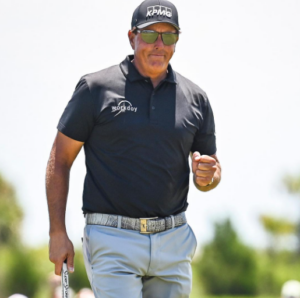
The Rise of a Left-Handed Legend
Nicknamed “Lefty” due to his unique left-handed swing (although he is naturally right-handed), Mickelson began his journey in golf at a young age. With the help of his father, he honed his skills early, which set the stage for his collegiate and amateur achievements.
Although I believed it was possible, I can’t believe this happened 👍 pic.twitter.com/lysjjrPqyb
— Phil Mickelson (@PhilMickelson) May 24, 2021
While attending Arizona State University, Mickelson became one of the top college golfers, winning three NCAA individual championships and cementing his reputation as a rising star in golf. In 1991, he won his first PGA Tour event as an amateur, a rare feat that showcased his immense potential.
Early Career Success and Notable Wins
Mickelson turned professional in 1992 and quickly established himself as a force to be reckoned with on the PGA Tour. During the 1990s, he collected several tour victories, but his quest for a major championship proved elusive until 2004, when he finally captured his first major title at the Masters.
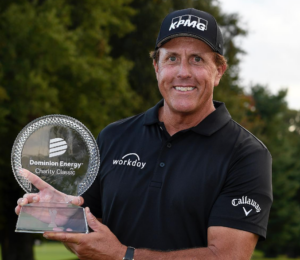
This win sparked a series of successful years for Mickelson, with additional major victories at the 2005 PGA Championship, the 2006 Masters, and the 2010 Masters, solidifying his place as one of golf’s premier players.
A Historic Win at the 2021 PGA Championship
In 2021, Mickelson achieved a historic milestone, winning the PGA Championship at the age of 50. This victory made him the oldest golfer to win a major championship, breaking records and proving his enduring skill and competitive spirit.
The win was a testament to his commitment to physical fitness, mental fortitude, and a never-give-up attitude, earning him admiration from fans and players alike.
Also Read: Phil Mickelson (Golfer): Bio, Wiki, Age, Career, Personal Life, Net Worth 2024 and Promotion
Phil Mickelson’s Professional Career: From Promising Start to PGA Dominance
Phil Mickelson, graduating from Arizona State University (ASU) in June 1992, wasted no time making a name for himself in professional golf. Already a standout amateur with an impressive resume, Mickelson’s transition to the PGA Tour was smooth and unconventional.
His win at the 1991 Northern Telecom Open, achieved while he was still an amateur, granted him a two-year exemption on the PGA Tour, a privilege that allowed him to bypass the rigorous Qualifying School (Q-School) process.
A Key Partnership: Hiring Jim “Bones” Mackay
One of Mickelson’s earliest decisions as a pro was to bring on Jim “Bones” Mackay as his caddy. The two started working together in 1992, forming a partnership that would endure for 25 years and become one of the most celebrated player-caddy relationships in the sport.
Early Tour Success and Career-Building Wins
With his tour exemption in place, Mickelson quickly showed that he could compete among the professionals, clinching early wins and demonstrating his distinctive style and skill. Known for his powerful drives and precise short game, Mickelson’s aggressive, risk-taking approach to golf thrilled fans and kept him at the forefront of PGA Tour discussions.
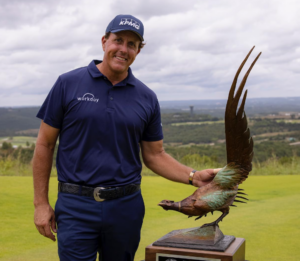
While he wasn’t able to secure a major title during his first decade on tour, he was a consistent contender, frequently finishing among the top players in various tournaments and establishing himself as a formidable force.
Major Breakthrough: The 2004 Masters
Mickelson’s talent was undeniable, but his lack of a major victory led to a label that no golfer enjoys: “best player never to win a major.” This changed in 2004 when he claimed his first major championship at the Masters.
The victory was historic not only for Mickelson but also for his fans, who had followed his journey and celebrated his success as he drained an 18-foot birdie putt on the final hole to claim the win. The 2004 Masters marked the start of an era for Mickelson, who went on to secure additional major titles in the years that followed.
Phil Mickelson Net Worth
Phil Mickelson, a seasoned American golfer and one of the sport’s most recognized figures, boasts a substantial net worth of approximately $300 million. Over his storied career, Mickelson has accumulated more than $800 million in total earnings, with his income largely stemming from tournament winnings and lucrative endorsement deals.
His annual income has fluctuated throughout his career, with peak earnings reaching between $80 to $100 million. In recent years, Mickelson’s earnings have been slightly lower but still impressive, estimated between $40 to $50 million annually, with endorsements making up a considerable portion.
Tournament Winnings and Career Earnings
Mickelson has earned over $100 million purely from tournament winnings, making him one of the highest earners in golf history. These winnings reflect his longstanding success on the PGA Tour, highlighted by six major championships and numerous tournament victories.
His earning power extends beyond prize money, however, as his reputation and persona have made him highly sought-after by sponsors.

Endorsements and Sponsorships
Endorsements have been a significant contributor to Mickelson’s financial success, with partnerships including some of the most prestigious brands in the world. Known for his personable nature and competitive edge, Mickelson has built lasting relationships with sponsors, which has enhanced his net worth.
His marketability continues to be strong, allowing him to generate substantial endorsement income even as he shifts into the later stages of his career.
Phil Mickelson’s Legacy and Financial Impact
As Mickelson continues to compete and expand his legacy through ventures like LIV Golf, his financial success serves as a testament to his influence on and off the golf course. His career earnings and net worth reflect both his talent as a golfer and his ability to connect with fans and sponsors alike.
With a legacy rooted in both skill and personality, Mickelson’s financial achievements set a standard for the earning potential within professional golf.

FAQ’S
1. Why did Phil Mickelson decide to end his longtime coaching partnerships?
Ans: Phil Mickelson has shared that his decision to part ways with longtime coaches stemmed from a desire to refresh his game and approach. After years with the same coaching techniques, he felt that change was necessary to continue growing as a player, especially as he navigates the later stages of his career.
2. What challenges does Mickelson face in breaking these bonds?
Ans: Mickelson has described the emotional difficulty of ending relationships that have been integral to his career. These bonds, built over years of collaboration and success, carry both personal and professional significance, making the decision to move on a challenging but necessary choice for him.
3. How has this coaching change impacted Mickelson’s game?
Ans: While it’s still early to assess the full impact, Mickelson has hinted at renewed motivation and a fresh perspective in his game. Adjusting to new coaching styles can be complex, but he sees this transition as a step towards reinvigorating his performance and refining his skill set.
4. What has Mickelson said about the progress he’s made since the change?
Ans: Mickelson has expressed optimism about the progress he’s made, noting that the change has allowed him to explore new techniques and mental strategies. He feels that these adjustments are helping him maintain a competitive edge and adapt to the evolving demands of the sport.
5. How have fans and the golfing community reacted to Mickelson’s decision?
Ans: Fans and the golfing community have shown a mix of support and curiosity regarding Mickelson’s decision. Many understand the need for athletes to make tough choices for their growth, while some are nostalgic about his past partnerships. Overall, there’s interest in seeing how this change influences his future performances.
Read More: What is Phil Mickelson Net Worth in 2023? Salary, Investment, Endorsements, Businesses More
